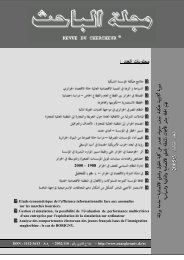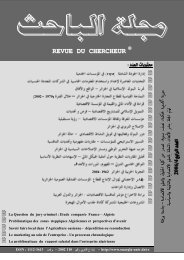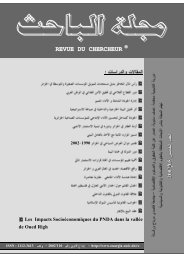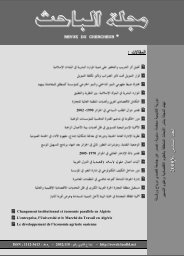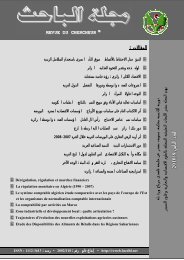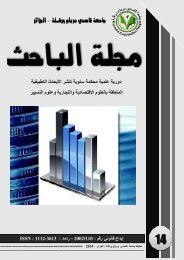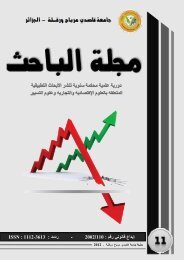El-BAHITH REVIEW Number 09 _ University Of Ouargla Algeria
Annual refereed journal of applied reserch in economic, commercial and managment sciences
Annual refereed journal of applied reserch in economic, commercial and managment sciences
Create successful ePaper yourself
Turn your PDF publications into a flip-book with our unique Google optimized e-Paper software.
Determina of Savings : An Empirical Evidence from African Countries, 1990-1999<br />
____________________________________________<br />
The rest of this paper is organized as follows. Section (2) reviews the literature, while section<br />
(3) outlines the empirical model, data and methodology. Section (4) reports the empirical results<br />
while section (5) provides some concluding remarks.<br />
2. Literature review :<br />
The importance of savings for investment and economic growth has received a considerable<br />
attention in growth theory . According to Todaro (1977) one of the principal ‘tricks’ of<br />
development necessary for any take-off is the mobilisation of domestic and foreign savings in order<br />
to generate sufficient investment to accelerate economic growth. This thesis is captured by<br />
different growth models . Every economy must save a certain proportion of its national income if<br />
only to replace worn out or impaired capital goods.<br />
Thus, according to the famous Harrod–Domar equation the rate of growth of GNP is<br />
determined jointly by the national saving ratio, and the national capital output ratio. More<br />
specifically, the growth rate of national income is positively related to the savings ratio and<br />
inversely related to the economy’s capital output ratio. The economic logic of this thesis is that in<br />
order to grow, economies must save and invest a certain proportion of their GNP. The more they<br />
can save, and therefore invest, the faster they can grow. The actual rate at which they can grow for<br />
any level of saving and investment depends on how productive that investment is. The ‘Tricks’ of<br />
economic growth and development, therefore, are simply a matter of increasing savings and<br />
investment. According to this theory the main obstacle to development was the relatively low level<br />
of new capital formation or investment in most poor countries. If a country wanted to grow and if it<br />
could not generate savings and investment, then it could seek to fill this ‘savings gap’ either<br />
through foreign aid or private foreign investment.<br />
The neoclassical growth models such as that of Solow (1956) suggest that an increase in the<br />
savings rate generates higher growth only in the short-run, during the transition between steadystates.<br />
The long-run equilibrium rate of growth is exclusively a function of technical progress and<br />
growth of labor force, both assumed to be exogenous. An important implication of the neoclassical<br />
economic growth theory is that changes in savings rates affect the level of output and not the longrun<br />
growth rate. An increase in savings increases the ratio of capital stock to the given labour<br />
supply and initially raises the growth rate of output per-capita (Bijan, 1999).<br />
“From macroeconomic theory perspective, if we assume a full employment economy, any<br />
amount of personal saving, ceteris paribus creates a gap in aggregate demand. This gap, unless met<br />
with an equal amount of real investment demand, will result in unemployment and could start a<br />
down ward chain reactions that lead to recessions. However, given the volatility of investment,<br />
-22-





